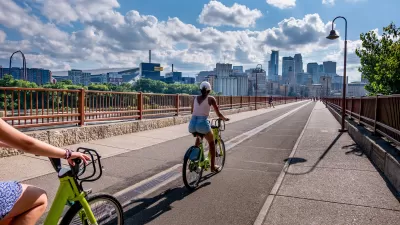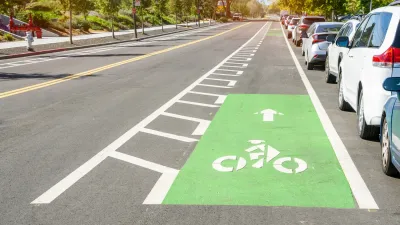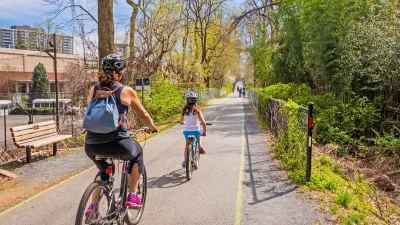Research reveals that, once a city reaches a certain threshold of bike infrastructure, opposition decreases and residents want more.

Has your city entered the ‘virtuous cycle’ of bikeability? Writing in Streetsblog USA, Kea Wilson describes the ‘tipping point’ at which residents begin calling for more bike infrastructure, signaling a desire to see biking as an everyday transportation mode.
The measure comes from advocacy group PeopleForBikes, which issues an annual list of City Ratings. Cities that score 50 or above on the organization’s SPRINT rubric, which “includes such measures as protected bike lanes, safe intersection treatments, and reduced speed limits that are unlikely to kill a cyclist in the event of a crash, among other factors,” are said to have reached the tipping point where “bike culture has firmly taken root.”
According to Martina Haggerty, senior director of local innovation at PeopleForBikes, “[That's] not to say that there aren't still improvements to be made [but it] probably means that more people are riding bikes in those communities because they feel safe and comfortable. And when more people start riding bikes, those people tend to become advocates for better bike infrastructure and for pro-bike policies, which, [in turn,] will get more people riding.”
This year, 183 communities achieved a score of 50 or higher, a dramatic jump from the 33 that reached that score in 2019. This “reveals for the first time just how fast these destinations have improved their biking scores over the years — and how, at a certain point, those wins become self-perpetuating.” However, those communities represent just 8 percent of the 2.300 communities on the list.
FULL STORY: Has Your City Passed the ‘Bikeability Tipping Point’?

Planetizen Federal Action Tracker
A weekly monitor of how Trump’s orders and actions are impacting planners and planning in America.

Congressman Proposes Bill to Rename DC Metro “Trump Train”
The Make Autorail Great Again Act would withhold federal funding to the system until the Washington Metropolitan Area Transit Authority (WMATA), rebrands as the Washington Metropolitan Authority for Greater Access (WMAGA).

The Simple Legislative Tool Transforming Vacant Downtowns
In California, Michigan and Georgia, an easy win is bringing dollars — and delight — back to city centers.

The States Losing Rural Delivery Rooms at an Alarming Pace
In some states, as few as 9% of rural hospitals still deliver babies. As a result, rising pre-term births, no adequate pre-term care and "harrowing" close calls are a growing reality.

The Small South Asian Republic Going all in on EVs
Thanks to one simple policy change less than five years ago, 65% of new cars in this Himalayan country are now electric.

DC Backpedals on Bike Lane Protection, Swaps Barriers for Paint
Citing aesthetic concerns, the city is removing the concrete barriers and flexposts that once separated Arizona Avenue cyclists from motor vehicles.
Urban Design for Planners 1: Software Tools
This six-course series explores essential urban design concepts using open source software and equips planners with the tools they need to participate fully in the urban design process.
Planning for Universal Design
Learn the tools for implementing Universal Design in planning regulations.
Smith Gee Studio
City of Charlotte
City of Camden Redevelopment Agency
City of Astoria
Transportation Research & Education Center (TREC) at Portland State University
US High Speed Rail Association
City of Camden Redevelopment Agency
Municipality of Princeton (NJ)





























